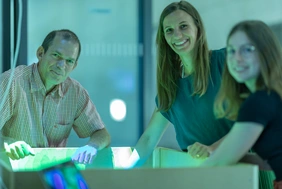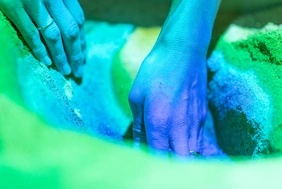It was a gimmick by Professor Georg Passig: For this year's ON Campus Festival, the Dean of Studies at the Faculty of Electrical Engineering and Information Technology had a carpenter from Köschingen build a sandpit out of Euro pallets. The highlight: the surface of the sand is recorded and analysed with millimetre precision by a 3D camera. At the same time, a projector, which should have been discarded, projects an image onto the sand from above. Depending on the distance to the 3D camera, the sand changes colour virtually. ‘If you dig a hole in a green sandy landscape, it turns blue, if you pile up a mountain, it turns brown,’ explains Passig.
His installation is an application of augmented reality, a now widely used technology that enriches the view of the real world with additional digital information. Modern head-up displays, for example, superimpose information from the navigation system directly onto the windscreen, thus ‘augmenting’ reality. At THI, augmented reality is part of the content of many degree programmes. Passig's sandbox can therefore be used by many of his colleagues in different contexts.
For Professor Sina Huber, who teaches computational data science, it is a good way to make abstract topics understandable for her students: ‘Data science and AI are important topics for the future. However, students often find the mathematical concepts behind machine learning difficult to understand,’ says Huber. This is exactly where the sandbox can help. ‘An essential concept of machine learning is an optimization process that serves to find the point at which a model works best and makes the fewest errors.’ This is comparable to searching for the deepest valley in a hilly landscape - and the students can understand this with the help of the box.
Passig's handicrafts can also be used in the Design Leadership Master's course: ‘At the interface between empirical research and strategic decisions, visualization can be used to gain a deeper understanding and bring together different schools of thought,’ explains Professor Bernhard Rothbucher. ‘At the same time, the sand formations offer the opportunity to visualize group discussions in space, save them, and use them as a basis for further discussion.’ The colourfully illuminated box therefore benefits researchers and students alike and encourages them to play with sand in the name of science.




![[Translate to English:] Logo Akkreditierungsrat: Systemakkreditiert](/fileadmin/_processed_/2/8/csm_AR-Siegel_Systemakkreditierung_bc4ea3377d.webp)








![[Translate to English:] Logo IHK Ausbildungsbetrieb 2023](/fileadmin/_processed_/6/0/csm_IHK_Ausbildungsbetrieb_digital_2023_6850f47537.webp)


